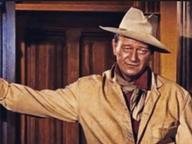Quiz Answer Key and Fun Facts
1. How did John Wayne get the name "Duke"?
2. As a young man, while studying law at the University of California, Wayne also had a promising football career ahead of him. Due to injury, his lost that scholarship and had to leave university as a result. What caused this injury?
3. When first starting out in bit parts in his movie career, Wayne was helped along the way in what turned out to be a lifelong friendship with director John Ford. During this time of his life, Wayne also became friendly with which famous gunfighter and lawman?
4. Born Marion Morrison, a name he definitely did not like, and re-christened John Wayne for his movie career, Wayne once appeared in film credits in his early days as Duke Morrison. True or false?
5. The first big budget film in which Wayne appeared was shown in wide screen for the first time, a format unknown to film audiences at the time. The film though was a flop. Why was this so?
6. After the flop of his first big budget film, Wayne was relegated for ten years to playing smaller roles again in what he referred to as his "80 horse operas" days. In one of these films, what dead end and non-moving role did he play?
7. Still struggling to make his way to the top, in what unlikely role was Wayne cast in a western - the first person actually to do so?
8. Just as an indication of the man's unwillingness to compromise his standards, he gave up a role in a 1950 western to actor Gregory Peck because the producer of that film had treated Wayne badly years before when he was a struggling actor. Which film was it?
9. In a 1954 interview with actress and gossip columnist Hedda Hopper regarding his failed second marriage, Wayne said, "We had a pretty good time together...". What is the remainder of that quote?
10. Wayne's hair started to thin quite early in his life during the 1940s, and he began wearing a hairpiece to disguise that fact. During a guest appearance at Harvard University he was once asked by a student there if his hair was real. Without missing a beat, Wayne replied that it was. Then he added what?
Source: Author
Creedy
This quiz was reviewed by FunTrivia editor
Nannanut before going online.
Any errors found in FunTrivia content are routinely corrected through our feedback system.

